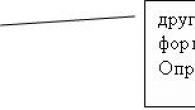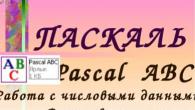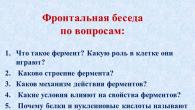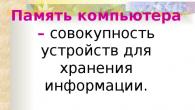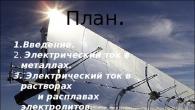When there was a lot of information surrounding a person, and he was unable to remember it, writing arose. Over time, it improved and became an integral part of Everyday life person. but a large number of paper media makes it difficult quick search necessary information, and with the advent of digital information and means for its transformation and storage, it became possible to take a different look at this problem. digital information has a number of advantages related to immunity to transmission interference and longer
Information storage is one of the main ones with which the concept of an information storage device, or a storage device, is inextricably linked. Miscellaneous devices can use various ways information storage. The collection of such devices is called memory. More often the concept of "information storage" is associated with computer technology.
Computer memory can be internal or external. Internal memory includes devices that ensure the operability of the computing system(computer). For example, operational Most of the storage devices known to the average user, such as a hard drive, USB flash drive, CD, refer to
Until recently, this was the only thing that the computer industry had to offer us. Now everyone has the opportunity to keep their personal information directly on the Internet, and without even spending money on it.

On the one hand, this is very convenient, since from any device that has access and view necessary information. Thus, there are no cases when a flash drive with information is forgotten at home, just on the day when it was really needed at work.
Storing information is accompanied by one unpleasant moment associated with its damage, loss or Any experienced user knows a few tricks on how to protect their information from loss. For example, you should not store valuable information on the hard drive, as there is a high probability of "catching" a virus that will destroy everything. You can also duplicate important information to multiple media at once.
Such information is usually stored on removable storage devices, for which certain storage conditions are created. But there is another way to provide secure storage information.

This is the use of "cloud" Internet services, in which case the user's information is stored on distributed servers on the Internet, and access to it is carried out through a login and password. This technology has about equal numbers of allies and opponents. Some don't trust at all global network their personal files while others, on the contrary, see the future in this.
IN modern world, especially in large cities where access to the global network is everywhere, such storage of information seems to be preferable. There is no need to buy, maintain and worry about the safety of photos or video archives.
That's just what will happen if the Internet connection suddenly breaks and the user will not be able to right time access your information?
A person stores information in own memory, as well as in the form of records on various external (in relation to a person) media: on stone, papyrus, paper, magnetic and optical media etc. Thanks to such records, information is transmitted not only in space (from person to person), but also in time - from generation to generation.
Variety of storage media
Information may be stored in various types: in the form of texts, in the form of figures, diagrams, drawings; in the form of photographs, in the form of sound recordings, in the form of film or video recordings. In each case, their carriers are used. Carrier - this the material medium used to record and store information.
The main characteristics of information carriers include: information volume or density of information storage, reliability (durability) of storage.
Paper media
The carrier with the most massive use is still paper. Invented in the 2nd century AD. in China, paper has served people for 19 centuries.
To compare the volumes of information on different media, we will use a universal unit - byte, assuming that one character of the text "weighs" 1 byte. A book containing 300 pages, with a text size of approximately 2000 characters per page, has an information volume of 600,000 bytes, or 586 KB. The information volume of the secondary school library, which fund is 5000 volumes, is approximately equal to 2861 MB = 2.8 GB.
As for the durability of storing documents, books and other paper products, it very much depends on the quality of the paper, on the dyes used to write the text, and on the storage conditions. Interestingly, until the middle of the 19th century (since that time, wood began to be used as paper raw material), paper was made from cotton and textile waste - rags. The inks were natural dyes. The quality of handwritten documents of that time was quite high, and they could be stored for thousands of years. With the transition to a wood base, with the spread of typewriting and copying tools, with the use of synthetic dyes, the shelf life of printed documents has decreased to 200–300 years.

Magnetic media
Magnetic recording was invented in the 19th century. Initially, magnetic recording was only used to preserve sound. The very first magnetic recording medium was steel wire with a diameter of up to 1 mm. At the beginning of the 20th century, rolled steel tape was also used for these purposes. Qualitative characteristics of all these carriers were quite low. The production of a 14-hour magnetic recording of oral presentations at the International Congress in Copenhagen in 1908 required 2,500 km, or about 100 kg of wire.
In the 1920s, there appeared magnetic tape first on paper, and later on a synthetic (lavsan) basis, on the surface of which a thin layer of ferromagnetic powder is applied. In the second half of the 20th century, they learned how to record an image on magnetic tape, video cameras and video recorders appeared.
On computers of the first and second generations, magnetic tape was used as the only type of removable media for devices. external memory. One reel of magnetic tape, used in the tape drives of the first computers, contained approximately 500 Kb of information.
Since the early 1960s, computer magnetic disks : an aluminum or plastic disc coated with a thin layer of magnetic powder a few microns thick. Information on a disk is arranged along circular concentric tracks. Magnetic disks are hard and flexible, removable and built into a computer drive. The latter are traditionally called hard drives, and removable floppy disks are called floppy disks.
"Winchester" computer- this a package of magnetic disks put on a common axis. The information capacity of modern hard drives is measured in gigabytes - tens and hundreds of GB. The most common type floppy disk 3.5 inches in diameter holds 2 MB of data. Floppy disks in Lately are going out of use.
In the banking system, widespread plastic cards. They also use the magnetic principle of recording information with which ATMs and cash registers work, connected with the information banking system.
Optical media
The use of the optical, or laser, method of recording information begins in the 1980s. Its appearance is associated with the invention of a quantum generator - a laser, a source of a very thin (thickness of the order of a micron) beam of high energy. The beam is able to burn on the surface of a fusible material binary code very high density data. Reading occurs as a result of reflection from such a “perforated” surface of a laser beam with less energy (“cold” beam). Thanks to high density Recording optical discs have a much larger information volume than single-disk magnetic media. The information capacity of an optical disc is from 190 to 700 MB. Optical discs are called CDs.
In the second half of the 1990s, digital versatile video discs (DVD) appeared. D digital V ersatile D isk) from large capacity, measured in gigabytes (up to 17 GB). The increase in their capacity compared to CDs is due to the use of a laser beam of a smaller diameter, as well as double-layer and double-sided recording. Think back to the school library example. Her entire book fund can be placed on one DVD.
Currently, optical discs (CD - DVD) are the most reliable material media. information recorded digitally. These types of media are either write-once - read-only, or rewritable - read-write.
Flash memory
Recently, there have been many mobile digital devices: digital photo and video cameras, MP3 players, PDAs, mobile phones, reading devices e-books, GPS-navigators and much more. All of these devices require portable storage media. But since everything mobile devices are quite miniature, then special requirements are imposed on the media for them. They must be compact, have low power consumption during operation and be non-volatile during storage, have a large capacity, high write and read speeds, and a long service life. All these requirements are met flash cards memory. The information volume of a flash card can be several gigabytes.
As an external media for a computer wide use received flash key fobs (“flash drives” - they are colloquially called), the release of which began in 2001. Large amount of information, compactness, high speed read-write, ease of use - the main advantages of these devices. The flash key fob connects to a computer's USB port and allows you to download data at a speed of about 10 Mb per second.
“Nano-carriers”
IN last years work is being actively carried out to create even more compact information carriers using the so-called “nanotechnologies”, working at the level of atoms and molecules of matter. As a result, one compact disc made using nanotechnology can replace thousands of laser discs. According to experts, in about 20 years, the density of information storage will increase to such an extent that every second of a human life can be recorded on a medium with a volume of about a cubic centimeter.
Organization of information storages
Information is stored on media so that it can be viewed, search for the necessary information, required documents, replenish and change, delete data that has lost its relevance. In other words, the stored information is needed by a person to work with it. The convenience of working with information repositories depends a lot on how the information is organized.
Two situations are possible: either the data is not organized in any way (this situation is sometimes called a heap), or the data structured. With the increase in the amount of information, the “heap” option becomes more and more unacceptable due to the complexity of its practical use (search, update, etc.).
The words “data are structured” mean the presence of some order of data in their storage: in a dictionary, schedule, archive, computer database. Reference books, dictionaries, encyclopedias usually use the linear alphabetical principle of organizing (structuring) data.
Libraries are the largest repository of information. Mentions of the first libraries date back to the 7th century BC. With the invention of printing in the 15th century, libraries began to spread throughout the world. Librarianship has centuries of experience in organizing information.
To organize and search for books in libraries, catalogs are created: lists of the book fund. The first library catalog was created in the famous Alexandrian Library in the 3rd century BC. With the help of the catalog, the reader determines the availability of the book he needs in the library, and the librarian finds it in the book depository. When using paper technology, a catalog is an organized set of cardboard cards with information about books.
There are alphabetical and systematic catalogs. IN alphabetic catalogs, the cards are arranged in alphabetical order of the names of the authors and form linear(single-level)data structure. IN systematic catalog cards are systematized according to the content of the books and form hierarchical data structure. For example, all books are divided into art, educational, scientific. Educational literature is divided into school and university. Books for school are divided into classes, etc.
IN modern libraries there is a change from paper catalogs to electronic ones. In this case, the search for books is carried out automatically. information system libraries.
Data stored on computer media (disks) have file organization. A file is like a book in a library. Like a library directory, the operating system creates a directory on disk, which is stored on dedicated tracks. The user is looking for desired file, browsing the directory, after which the operating system finds this file on the disk and provides it to the user. At first disk media small volume, a single-level file storage structure was used. With the advent of large-capacity hard drives, a hierarchical file organization structure began to be used. Along with the concept of “file”, the concept of a folder appeared (see “ Files and file system”).
A more flexible system for organizing data storage and retrieval are computer databases (see . “Database”).
Reliability of information storage
The problem of information storage reliability is associated with two types of threats to stored information: destruction (loss) of information and theft or leakage of confidential information. Paper archives and libraries have always been in danger of physical extinction. The destruction of the Library of Alexandria mentioned above in the 1st century BC brought great damage to civilization, since most of the books in it existed in a single copy.
The main way to protect information in paper documents from loss is their duplication. The use of electronic media makes duplication easier and cheaper. However, the transition to new (digital) Information Technology created new information security problems.
In the process of studying the computer science course, students acquire certain knowledge and skills related to the storage of information.
Students learn to work with traditional (paper) sources of information. The standard for the primary school notes that students must learn to work with non-computer sources of information: reference books, dictionaries, library catalogs. To do this, they should be familiarized with the principles of organizing these sources and with the techniques optimal search in them. Since these knowledge and skills are of great general educational importance, it is desirable to give them to students as early as possible. In some programs of the propaedeutic informatics course, much attention is paid to this topic.
Students must master the techniques of working with shifts. computer media information. Increasingly rare in recent years, floppy magnetic disks have been used, which have been replaced by capacious and fast flash media. Students should be able to identify information capacity carrier, volume free space, compare the volumes of saved files with it. Students must understand that for long-term storage large volumes most suitable remedy are optical discs. If you have a CD burner, teach them how to write files.
An important point of training is to explain the dangers to which computer information is exposed from malware - computer viruses. Children should be taught the basic rules of “computer hygiene”: antivirus control all newly arriving files; regularly update anti-virus databases.
Under the storage of information (from keep - keep safe / intact) should be understood as the content of information in the external memory of the computer.
Such concepts as information carrier (memory), internal memory, external memory, information storage are associated with the storage of information. The carrier of information is physical environment, directly storing information. The main carrier of information for a person is his own biological memory (human brain). It can be called internal memory, since its carrier - the brain - is inside a person. All other types of information carriers can be called external (in relation to a person). The types of these media have changed over time from stone to paper. The development of information technology has led to the creation of magnetic, optical and other modern species information carriers.
Information storage is a set of data organized in a certain way on external media, intended for long-term storage and permanent use. Examples of repositories are document archives, libraries, directories, file cabinets. The main information unit of the storage is a certain physical document - a questionnaire, a book, a file, a dossier, a report, etc. The storage organization is understood as the presence of a certain structure, i.e. orderliness, classification of stored documents. Such an organization is necessary for the convenience of maintaining the repository: replenishing it with new documents, deleting unnecessary documents, information search, etc.
The knowledge stored in human memory can be considered as internal storage information, but the organization of this repository is difficult for us to understand. The main property of human memory is the high speed of reproduction of the information stored in it. But compared to external storage human memory is less reliable. Therefore, for more reliable storage, a person uses external media, organizes storage of information.
The main properties of the information storage are the amount of information stored, the reliability of storage, the access time (i.e., the search time necessary information), availability of information security.
Information stored on computer memory devices is called data. Organized data stores on external memory devices of a computer are commonly called databases.
IN modern computers The main storage media for external memory are magnetic and optical disks. Consider how information is stored on magnetic disks. This approach is justified by the fact that optical discs for this purpose began to be used much later, and therefore, in order to ensure compatibility with magnetic devices they largely mimic the structure of the latter.
Placement of information on carriers. A conventional magnetic disk has two surfaces suitable for placing information, which in the technical literature are called sides of the disk. Considering that in storage hard drives several disc plates can be installed on one axis, the total number of sides can be more.
Each surface is served by its own magnetic head. All heads are assembled into a single mechanical unit and can move along the radius of the discs, and this movement is discrete, i.e. the heads occupy only strictly defined positions relative to the disk. Finally, each track is divided into separate sectors(sector) (Fig. 1.4). A sector is an indivisible piece of information and can only be read in its entirety. The last coordinate of the information on the disk is the number of the required byte in the sector.
So, the position of a byte of information on a magnetic disk is determined by four “coordinates”: the side number, the disk track number, the sector number and the byte number in it. Such a data storage system is complex and requires some effort to retrieve them. Therefore created special programs, which allow the user to extract the necessary data without requiring him to know all these coordinates.
Data storage units. When storing data, two problems are solved: how to store data in the most compact form and how to provide them with convenient and fast access(if access is not provided, then this is not storage). To ensure access, the data must have an ordered structure, and thus it becomes necessary to additionally record the address data. Without them, you cannot access the right elements data included in the structure.
Since address data also has a size and is also subject to storage, it is inconvenient to store data in small units such as bytes. It is inconvenient to store them in larger units (kilobytes, megabytes, etc.), since incomplete filling of one storage unit leads to storage inefficiency.
The unit of data storage is a variable length object called a file. A file is a sequence of arbitrary number of bytes with a unique name of its own. Usually, data of the same type is stored in a separate file. In this case, the data type determines the file type.
In the file definition Special attention given a name. It actually carries address data, without which the data stored in the file will not become information due to the lack of an access method to them. In addition to the functions associated with addressing, a file name can also store information about the type of data contained in it. For automatic means This is important when working with data, because by the name of the file they can automatically determine the appropriate method for extracting information from the file. Obviously, the filename must be unique, as this ensures unambiguous access to the data.
The concept of file structure. File storage is organized in hierarchical structure, which in this case called file structure. The top of the structure is the name of the medium on which the files are saved. Further, the files are grouped into directories (folders), within which nested directories (folders) can be created. The file path starts with the device name and includes all the names of the directories (folders) through which it passes. The character “\” (backslash) is used as a separator.
The uniqueness of the file name is ensured by the fact that full name filename is considered to be its own filename along with its path. It is clear that in this case there cannot be two files with identical full names on one medium.
An example of writing a full file name:
<имя носителя>\<имя каталога1 >\...\<имя каталогаM>\ <собственное имя файла>
It should be borne in mind that sectors with information of one file are not necessarily located in order in one place on the disk. When recording, the system actively uses free places, which are formed upon removal junk files. As a result, individual parts of the file may well end up in different areas of the disk, which will noticeably slow down access to information. To eliminate this phenomenon, operating systems usually includes special file defragmentation utilities.
This approach to organizing data storage has historically been due to the fact that, as material carrier data were used on magnetic disks. At the same time, the disk surface on which data was written was formatted: it was divided into tracks and sectors. Formatting programs ensured the creation of a sector of 512 bytes. Thus, to write data belonging to one file, as a rule, several sectors are required. The figure clearly shows that the sectors on the outer tracks of the disk have larger size than those closest to the center. This suggests that the track data should be recorded more reliably. Therefore, the zero track, which serves to store the most important system information, is always placed on the outer ring of the disk surface.
The concept that will be discussed is widespread in our daily life. Information is a capacious word, belongs to general scientific categories and occupies importance in different sciences.
The word itself came to us from the Latin language and in translation it sounds like awareness. In fact, this concept is abstract and has several meanings that depend specifically on something that defines the types of information. But still, the meaning of the word is that it is, first of all, a set of specific information, preserved and disseminated. And they, in turn, define knowledge, which is always expressed in different forms. They surround a person always and everywhere, because without this the existence of life itself is impossible.
Various kinds of information are found everywhere. We all know that from the seed of an apple tree only an apple tree will grow and nothing more. This is at the genetic level inherent in the tree, and nothing can be changed. Air is a source of information for all trees (and not only): by its state, trees can determine the time when they need to wake up to life. And take a Flock flies only a certain route, which is set in their genes, and it is not possible for them to turn off it.
In the modern world this definition According to the presentation, method of storage and encoding, it is divided into the following types of information:
Graphic (sometimes expressed by visual means);
Sound;
Text;
Numeric;
Video information.
The first specified type of information exists in drawings, paintings, photographs, diagrams, drawings. It has been known since the appearance of the first representatives of the future society. Sound information is expressed in sounds. That's enough too ancient definition. Text is a way of designating speech with symbols, that is, letters. Numerical is similar to it: encoding information using numbers. The latest invention in the modern world was video information - a way of storing and transmitting "live" pictures of the world. In addition to all the types of information described, there is also (sensations, smells, tastes, etc.)
Any kind of information requires ways to store and transmit it, especially over long distances. Initially, they used light signals, then - radio waves. Since the advent of computers, storing and transmitting any information has become much easier. Information can be stored in different formats. electronic media: magnetic disks, laser discs, special storage devices, such as flash cards. Every day there are new ways and devices. Any concept is processed without problems by means of a computer. Processing includes reproduction, transmission, transformation, recording of data. To do this, you only need to be able to use a computer and programs specially designed for such actions.
And, of course, the main information of our time is presented in the global Internet. The methods of storage and transmission here are somewhat different from those familiar and familiar to humans. Since its volumes on the Internet are very large, the ways of working with it are special. Software is improved every day, which makes it possible to work with such information collectively and constantly.
Properties
Information, as we have already said, is a specific object, and like all of them, it has certain properties, which can be listed for a long time. Let us dwell only on the most important criteria. So valuable and useful information first of all should be:
Reliable;
Objective;
up-to-date;
The article is very well written plain language. Experienced computer users may skip the text.
About information and computer disks
You have heard that there is a lot of information inside a computer. That a computer can "surf the Internet", store "pictures", run games, print texts, and there are "some programs" in it.
In general, this is correct. But there is something else that needs to be known to make it easier to understand the essence.
When we turn on the computer, we can see some inscriptions on the screen, changing pictures, flashing rectangular frames, and so on. Where this is all taken? All computer content (texts, photos, music, movies, programs, games) is called " information". It is stored inside the computer.
But where exactly is all this located? Look at your computer. Think.. scratched with a carnation on back cover? No. On small pieces of paper, rolled up and stuffed into a hole from the bottom? Hardly.
The information in a computer is stored on a special such device, in such a small iron box, with the name "disk"
Disk- this is such a special device, "device", "box" - designed to store all the information that is already on the computer. So, we have a computer, and inside the computer disk, on which is stored information.
For many who are still new to computer matters, the concept is information - pretty blurry. Let's make it more specific so that it's easier for us to discuss everything else. Imagine that you have a paper notebook in which you wrote down the birthdays of your friends, relatives and everyone you care about. Once a week, you look through this notebook and say to yourself: "So .. you must not forget to congratulate your friend Vasya on his birthday, in two days." And another time: "Oh! I almost forgot. Tomorrow is my pet parrot's birthday. I need to buy him something tasty."
I want to say that the contents of your notebook are what they are. information. You looked through it (searched it) - and made the necessary conclusions. And no one was forgotten to congratulate on time. Now imagine - the lines from your notebook appeared on the computer screen. Let you not yet know how they got there, but you can imagine it. And now, instead of a notepad, you read the inscriptions on the screen. And now on the screen, instead of a notebook, the dates of birth of Vasya's friend, Kesha's parrot or the Minister of Finance of Honduras are recorded. What does this mean?
That even in Honduras there is finance. It's a joke. Actually this means that information, which you are accustomed to and which used to be in your notebook is now stored in your computer. Where exactly is it stored on the computer? Right! On disk.
You heard that you can watch movies on your computer. What is a film? That's right, that too information. On the computer, you can listen to music - this is also a kind information. Only this information is for your ears. On a computer, you can view photos - this is information for your eyes.
Let's conclude: Everything that you can see on a computer screen or hear from a computer is INFORMATION.
Learn more about information storage
I told you that information in a computer is stored on a disk. In fact, the word "disk" means various technical devices, various technical "things" that can be permanently inside the computer, or can be connected to it from time to time and then disconnected. All these devices have one thing in common - they store inside themselves information. And they allow the computer to which they are connected to extract this information into the light.
For example, if you have a laptop or desktop computer, then inside, as a rule, there is HDD . This is really some kind of very useful metal box that is hidden inside the computer case. It can only be seen if you open the inside of the computer. It is permanently installed inside, the computer needs it, on it it stores important information that is required so that the computer can even turn on and start working. But in addition to important computer information, HDD allows you to store your favorite photos, movies, music, e-books and so on. How much free space is enough.
 Let's delve a little further into technical details. A little bit. I said that the hard drive is a metal box. But what is inside this box? And why is the box called - a hard drive - if it is not a round object at all, but a rectangular one?
Let's delve a little further into technical details. A little bit. I said that the hard drive is a metal box. But what is inside this box? And why is the box called - a hard drive - if it is not a round object at all, but a rectangular one?
The fact is that inside this box there really is a disk, a metal one, it really rotates with a motor that is hidden inside this box. Do you remember the vinyl records with the recordings of the Orera ensemble or the master of the Soviet patriotic song Iosif Kobzon? Here, the inner round "plate" hard drive something like a record with a melody. The purpose of both of them is to store recorded information. I hope you understand that the melodies on a vinyl record can be called information.
Imagine being lucky today. You managed to buy a record with new songs by "Syabrov" in a village store. But if you don't have a player, a gramophone, into which you can put this record, you won't be able to enjoy the music. All you have to do is spin the record on your finger and sing along. This means that in addition to the disc (record) itself, we also need a device that will play the disc. Let's put it scientifically. We have "information carrier" disc, disc. To use this information (listen to music) - we need "reader" information - player.
So here it is HDD(a box inside the computer) contains both a "media" and a "reader". If we take vinyl record and glue it forever to the player - we get a hard drive. The storage medium, in this case, is inseparable from the reading device. Therefore, it is impossible to pull out a round plate on which information is recorded from a hard disk. He will break, so he - NON-REMOVABLE.

But there are also REMOVABLE devices to store information. Have you ever seen optical disc? They are also called DVD ("di-vi-di") disks, CD ("si-di") disks. Now on such disks they sell music, films, computer games. Information is recorded on the plastic disc itself, but the reader (player) is located separately. For example, it is built into a computer and has a narrow slot on the side. You can insert the desired optical disc into this slot, watch a movie, then pull out this disc, insert another one - with a new movie. In this case, we see that the reader optical discs- this is a separate "thing", and the information that this device can play is located on optical discs called DVDs or CDs. These discs are usually stored on a cabinet shelf, in plastic boxes.
The computer also has a built-in reader. floppy disks. This is a separate type of disk. These discs can also be inserted and removed from the computer. A small amount of information is placed on such a disk, so such disks are becoming obsolete. Many modern computers and laptops do not have a floppy disk drive.
So. Let's paint a short picture of what has been said. We have a computer with a hard drive inside it. Which cannot be pulled out, it is always inside the case. It has information on it. This is clear? But at the same time, a device can also be located inside the computer. DVD reading discs, with a slot on the side where you can insert any optical disc. There is no information in the DVD reader itself, but if we insert an optical disc into it, the information will appear. The device will be able to read the information from the disk we inserted. Thus, our computer will have two storages of information at the same time: a hard drive and a DVD drive with some kind of disk inserted into it (with a new computer game, for example)
To be continued...
How to learn to program in 1C from scratch?
How to work as a 1C programmer and get up to 150,000 rubles a month?

SIGN UP FOR A FREE
2-WEEK COURSE
"PROGRAMMING in 1C FOR BEGINNERS"

The course will come to email. Become a programmer by completing step-by-step tasks.
All you need to participate is a computer and internet.
Free access to the course:
sp-force-hide ( display: none;).sp-form ( display: block; background: #eff2f4; padding: 5px; width: 270px; max-width: 100%; border-radius: 0px; -moz-border -radius: 0px; -webkit-border-radius: 0px; font-family: Arial, "Helvetica Neue", sans-serif; background-repeat: no-repeat; background-position: center; background-size: auto;) .sp-form input ( display: inline-block; opacity: 1; visibility: visible;).sp-form .sp-form-fields-wrapper ( margin: 0 auto; width: 260px;).sp-form .sp -form-control ( background: #ffffff; border-color: #cccccc; border-style: solid; border-width: 1px; font-size: 15px; padding-left: 8.75px; padding-right: 8.75px; border -radius: 4px; -moz-border-radius: 4px; -webkit-border-radius: 4px; height: 35px; width: 100%;).sp-form .sp-field label ( color: #444444; font- size: 13px; font-style: normal; font-weight: bold;).sp-form .sp-button ( border-radius: 4px; -moz-border-radius: 4px; -webkit-border-radius: 4px; background-color: #f4394c; color: #ffffff; width: 100%; font-weig ht: 700; font-style: normal font-family: Arial, "Helvetica Neue", sans-serif; box-shadow: none -moz-box-shadow: none; -webkit-box-shadow: none; background: linear-gradient(to top, #e30d22 , #f77380);).sp-form .sp-button-container ( text-align: center; width: auto;)

